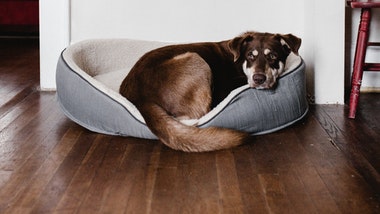Most humans are familiar with sleep disorders that they can develop. Insomnia, sleep walking, narcolepsy, sleep apnea are only a few examples. It might come as a surprise to you to hear that dogs may have these issues as well. Even if they are uncommon events, it is vital to recognize the signs so that you can help them, and any root issue must quickly be managed.
Insomnia
Insomnia means difficulty sleeping, either at the beginning of the night, or waking up at night, and being unable to fall back to sleep. Insomnia is also a symptom of some other problem, such as injury, anxiety, or disease, but is often correlated with old age in dogs.
When dogs get older, they are more likely to have a disorder that causes pain, such as joint or digestive problems. This makes it difficult for them to get relaxed and sleep through the night. Bladder issues can even make your senior dog wake up, and they may need to go out during the night, even if they’re well trained.
Rapid Eye Movement (REM) Behavior Disorder and Periodic Limb Movement Disorder
Dogs are known to paw in the air while sleeping, but certain dogs are very restless during REM sleep and display signs of a human condition called REM behavioral disorder. Dogs with this active REM cycle can run into walls, attack objects, or bite, even though they are normally gentle on waking. Unlike sleepwalking, these dogs do not seem disoriented if they are woken up during these active REM cycles.
Sleep Apnea
Another usually unusual sleeping condition that your pussy can encounter is sleep apnea. However, this condition is common in obese dogs or flat-faced breeds such as the English bulldog or pug. When a dog suffers from sleep apnea, they can wake up for about 15 seconds at a time. This can trigger constant interruptions in sleep patterns. These interruptions will make your dog feel sleepy and lethargic all day long.
If your canine friend likes to snore excessively, this may be a symptom of sleep apnea. Untreated, this disease can be life-threatening, so if you have any concerns, you should bring it to your vet’s notice. If identified, your canine friend’s care can comprise of weight loss, surgery, or steam humidifiers – all based on the reasoning behind their sleep apnea.
Narcolepsy
Narcolepsy is most often seen in young dogs, and can be dangerous based on what they do when they fall asleep. However, it should be handled as efficiently as possible to prevent it from having a major adverse impact on the quality of life of your canine.
Suddenly, a dog with narcolepsy will fall asleep, collapsing on its side. The muscles relax and the eyelids twitch, pretending to be in a deep sleep cycle of the REM. If you clap your hands or make a loud noise, a narcolepsy dog will unexpectedly wake up. Most episodes of narcolepsy are followed by extreme excitement or physical exercise.
Never-ending sleep disruptions will make your dog feel tired and inactive all day long. Sleep apnea is most common in dogs such as overweight dogs and Frenchie Dogs. So, if your dog has sleep apnea, don’t neglect it. Visit the vet for proper medical care.
To help treat and diagnose patients, i-STAT Alinity v is an simple-to-use, portable veterinary analyzer that allows electrolyte, chemistry, acid base, blood gas, and hematology testing on a single portable device.




